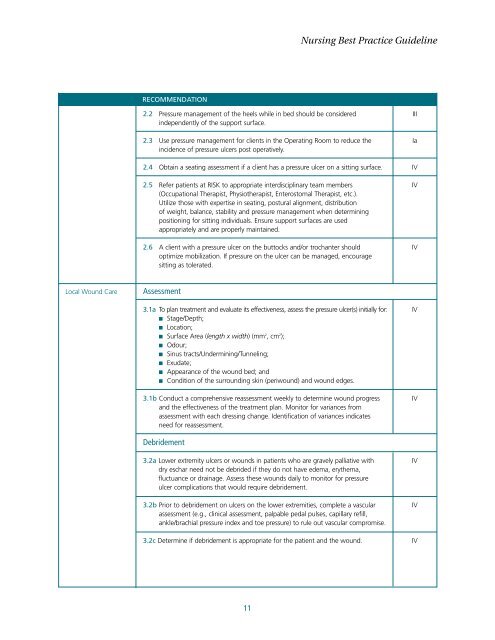RNAO BPG Pressure Ulcers Stage I to IV - Faculty of Health ...
RNAO BPG Pressure Ulcers Stage I to IV - Faculty of Health ...
RNAO BPG Pressure Ulcers Stage I to IV - Faculty of Health ...
You also want an ePaper? Increase the reach of your titles
YUMPU automatically turns print PDFs into web optimized ePapers that Google loves.
Nursing Best Practice GuidelineRECOMMENDATION2.2 <strong>Pressure</strong> management <strong>of</strong> the heels while in bed should be considered IIIindependently <strong>of</strong> the support surface.2.3 Use pressure management for clients in the Operating Room <strong>to</strong> reduce the Iaincidence <strong>of</strong> pressure ulcers post operatively.2.4 Obtain a seating assessment if a client has a pressure ulcer on a sitting surface. <strong>IV</strong>2.5 Refer patients at RISK <strong>to</strong> appropriate interdisciplinary team members <strong>IV</strong>(Occupational Therapist, Physiotherapist, Enteros<strong>to</strong>mal Therapist, etc.).Utilize those with expertise in seating, postural alignment, distribution<strong>of</strong> weight, balance, stability and pressure management when determiningpositioning for sitting individuals. Ensure support surfaces are usedappropriately and are properly maintained.2.6 A client with a pressure ulcer on the but<strong>to</strong>cks and/or trochanter should <strong>IV</strong>optimize mobilization. If pressure on the ulcer can be managed, encouragesitting as <strong>to</strong>lerated.Local Wound CareAssessment3.1a To plan treatment and evaluate its effectiveness, assess the pressure ulcer(s) initially for: <strong>IV</strong>■ <strong>Stage</strong>/Depth;■ Location;■ Surface Area (length x width) (mm 2 , cm 2 );■ Odour;■ Sinus tracts/Undermining/Tunneling;■ Exudate;■ Appearance <strong>of</strong> the wound bed; and■ Condition <strong>of</strong> the surrounding skin (periwound) and wound edges.3.1b Conduct a comprehensive reassessment weekly <strong>to</strong> determine wound progress <strong>IV</strong>and the effectiveness <strong>of</strong> the treatment plan. Moni<strong>to</strong>r for variances fromassessment with each dressing change. Identification <strong>of</strong> variances indicatesneed for reassessment.Debridement3.2a Lower extremity ulcers or wounds in patients who are gravely palliative with <strong>IV</strong>dry eschar need not be debrided if they do not have edema, erythema,fluctuance or drainage. Assess these wounds daily <strong>to</strong> moni<strong>to</strong>r for pressureulcer complications that would require debridement.3.2b Prior <strong>to</strong> debridement on ulcers on the lower extremities, complete a vascular <strong>IV</strong>assessment (e.g., clinical assessment, palpable pedal pulses, capillary refill,ankle/brachial pressure index and <strong>to</strong>e pressure) <strong>to</strong> rule out vascular compromise.3.2c Determine if debridement is appropriate for the patient and the wound. <strong>IV</strong>11
















